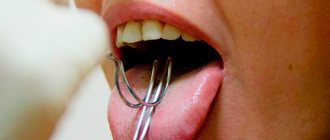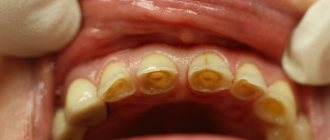A set of exercises for the development of a short frenulum of the tongue
Anastasia Shcherbinina
"Painter". You must perform the exercise with your mouth wide open and a smile. The tip of the tongue should be drawn across the palate, starting from the teeth to the throat, while the lower jaw should not move. The exercise is accompanied by a rhyme:
It's time to paint the rooms. A painter was hired. We lower our jaws and help the painter.
"Drum". Performed with an open mouth and a smile. The essence of the exercise is the repeated pronunciation of the letter [D]. It needs to be pronounced as clearly as possible. When pronouncing a sound, the tongue should rest against the upper teeth, and the mouth should be kept open. While doing this exercise, the child may involuntarily close his mouth; to prevent this from happening, you should hold a stick about 1 cm wide between his teeth, it could be a toothbrush handle or some other object.
We beat the drum hard and all together we sing: “D – d – d – d!”
"Reach your nose." Just like in the previous exercises, you need to open your mouth and smile. The edge of the tongue must be pulled towards the nose and lowered towards the upper lip. Parents need to ensure that while performing these manipulations, the lips and lower jaw are motionless and the tongue is not compressed.
"Swing". The child should smile and open his mouth, and on the count of “one or two,” alternately touch the upper and lower teeth. The lower jaw should remain motionless.
"Football". The essence of the exercise is that you need to alternately press the tip of your tongue first to one cheek, then to the other, as if swinging a ball in your mouth.
"Kitty". Children really like this exercise. You need to put some jam, ice cream or sour cream on a small plate and let the child lick the treat like a kitten.
"Harmonic". The tongue should be pressed to the palate and, without lifting it, open and close the mouth.
I play the harmonica, open my mouth wider, press my tongue to the roof of my mouth, lower my jaw.
"Horse". Starting position: smile and open your mouth. Click your tongue like horses click. The tip of the tongue should not be pulled out or tucked down, and the lower jaw should remain motionless.
We are riding, riding a horse along a smooth path.
A neighbor invited us to visit us for sweet pudding.
We arrived at lunchtime, but the neighbor was not at home.
"Fungus". The tongue should be pressed to the palate - this is the cap of the mushroom, and the frenulum is the leg, the lips should be kept in a smile.
“Reach your chin.” In the process of performing the tenth exercise, the baby should reach with his tongue to the tip of the chin; the further he can reach, the greater the stretch of the frenulum.
During the exercises, you can use additional objects, for example, a rubber ring, it can be cut from a pipette. The child opens his mouth, places the ring on the tip of his tongue, presses it to the roof of his mouth and closes his mouth.
How to do speech therapy massage for short tongue frenulum in children
A special massage helps to lengthen the hyoid ligament very effectively. The child can do it independently or with the help of parents.
Massage to stretch the hypoglossal ligament
Using your thumb and index finger, you need to grab the tip of your tongue and lift it up. The mouth should be open during the massage. Using the fingers of the other hand, you need to move along the frenulum from bottom to top with stretching movements, as if pulling it out.
The index and middle fingers should be placed under the tongue so that the frenulum is between them. Use your thumb to press on the front of the tongue and make outward lengthening movements. During such manipulation, the index and middle fingers should be motionless.
The massage can be performed by simply stretching the tongue in different directions. Grasp the tip and gently pull the tongue out
Exercises to normalize breathing function
Exercise No. 1 Full breathing. Take a long breath through your nose. During inhalation, the abdomen “inflates”, then the chest expands. When you exhale (through the nose), on the contrary, the volume of the chest first decreases, then the stomach retracts.
Exercise No. 2 Chest breathing. Exhale. Take a long breath through your nose. At this time, the chest expands and the stomach retracts. When you exhale (through the nose), the stomach retracts.
Exercise No. 3 Abdominal breathing. Exhale. Take a long breath through your nose. At this time, the stomach protrudes. When you exhale (through the nose), the stomach retracts.
Exercise No. 4 The skill of full, extended exhalation. Walk at an average pace. Inhale and exhale only through the nose. Inhale for three steps, exhale for four steps. After three to four days, the duration of exhalation should be increased by one count (5,6, etc.)
Exercise No. 5 Inhale and exhale alternately through one nostril (press the second nostril tightly with your finger).
Additional special exercises
Exercise No. 1. Slowly push the lower jaw forward until the cutting edges of the lower incisors are positioned in front of the upper ones. Hold the lower jaw in this position for 10 seconds, then slowly return to its original position.
Exercise No. 2. Perform the same exercise with a spank of the head, first to the right, then to the left. The load increases when performing the exercise while standing. The head is slightly tilted back, the lower jaw is slowly pushed forward until the lower incisors are positioned in front of the upper ones.
Exercise No. 3 (with the vestibular plate). The vestibular plate is placed in the vestibule of the oral cavity, with 1 finger of the right hand it is pulled forward by the ring and held with pursed lips.
Exercise No. 4. Place a folded strip of paper between your lips and purse your lips. The paper is held for up to 30-50 minutes during quiet games, drawing, reading, or when the child is watching TV.
Exercise No. 5. Perform the previous exercise, replace the strip of paper with a metal disk with a diameter of 2.5-3 cm, a thickness of 1.5 mm and a mass of about 6.5 g. The disk clamped between the lips should be positioned horizontally, it is necessary to ensure that the disk is only clamped lips, not teeth. The exercise is performed until fatigue (from 30 seconds to several minutes).
Exercise No. 6 (with a plastic plate). The child presses the edge of the plate, 1-2 mm thick and 30-35 mm wide, with his lips. 60-120 mm long. and holds it in a horizontal position. Some kind of weight is placed on the plate. Increasing the load causes increased clenching of the lips.
Exercise No. 7. Small cotton rolls are placed in the area of the transitional fold of the vestibule of the oral cavity on both sides of the frenulum of the upper lip. Close your lips and pronounce a series of phrases containing labial sounds (“b”, “m”, “p”).
Exercises to normalize breathing function
Exercise No. 1 Full breathing. Take a long breath through your nose. During inhalation, the abdomen “inflates”, then the chest expands. When you exhale (through the nose), on the contrary, the volume of the chest first decreases, then the stomach retracts.
Exercise No. 2 Chest breathing. Exhale. Take a long breath through your nose. At this time, the chest expands and the stomach retracts. When you exhale (through the nose), the stomach retracts.
Exercise No. 3 Abdominal breathing. Exhale. Take a long breath through your nose. At this time, the stomach protrudes. When you exhale (through the nose), the stomach retracts.
Exercise No. 4 The skill of full, extended exhalation. Walk at an average pace. Inhale and exhale only through the nose. Inhale for three steps, exhale for four steps. After three to four days, the duration of exhalation should be increased by one count (5,6, etc.)
Exercise No. 5 Inhale and exhale alternately through one nostril (press the second nostril tightly with your finger).
Exercise No. 6 Exhale. Pinch your nose with your fingers. Slowly count out loud to 5, then take a deep breath and exhale through your nose.
Exercises to strengthen the pharyngeal muscles
Exercise No. 1 Alternately tilt your head back as much as possible, leaning forward.
Exercise No. 2 Throw your head back. In this position, alternately tilt your head towards the right and left shoulder.
Exercise No. 3 Throw your head back, in this position alternately turn your head, without releasing your chin, to the right, then to the left.
Exercises to normalize breathing function
Exercise No. 1 Full breathing. Take a long breath through your nose. During inhalation, the abdomen “inflates”, then the chest expands. When you exhale (through the nose), on the contrary, the volume of the chest first decreases, then the stomach retracts.
Exercise No. 2 Chest breathing. Exhale. Take a long breath through your nose. At this time, the chest expands and the stomach retracts. When you exhale (through the nose), the stomach retracts.
Exercise No. 3 Abdominal breathing. Exhale. Take a long breath through your nose. At this time, the stomach protrudes. When you exhale (through the nose), the stomach retracts.
Exercise No. 4 The skill of full, extended exhalation. Walk at an average pace. Inhale and exhale only through the nose. Inhale for three steps, exhale for four steps. After three to four days, the duration of exhalation should be increased by one count (5,6, etc.)
Exercise No. 5 Inhale and exhale alternately through one nostril (press the second nostril tightly with your finger).
www.Logopedy.ru
Natalya Aleksandrovna Molchanova, speech pathologist, 1st qualification category, leading speech therapist at Ramensky Speech Therapy Center, Moscow Region
Original article:
I am a speech therapist with extensive experience and I want to share with you my observations and impressions of communicating with different parents who come to our speech therapy center and seek help.
I want to talk about such a problem as a short frenulum of the tongue ( hyoid) . If orthodontists or other doctors offer you an operation to trim the frenulum, do not rush to agree to their proposal.
Firstly, it is a mechanical injury for children. Secondly, this is a psychological trauma, which can lead to stress in children. And you will turn to psychologists and neurologists for help. But why do you need this? There are ways without the intervention of doctors. For example, you can invite your child to lick the convex part of a tablespoon from bottom to top. Then the hyoid frenulum will gradually stretch, provided that you do this simple exercise every day.
But the best way is to contact a speech therapist. A specialist who knows tongue massage will also be able to solve the problem of stretching the hyoid frenulum professionally, without pain and problems for your beloved child. So, feel free to ask speech therapists for help.
In addition, some parents come to us at the Ramensky Center for help with a very delicate problem, namely: children, having reached a certain age, cannot swallow solid food and parents suffer, coming up with ways to feed the child. In this case, you should also contact a speech therapist who knows tongue massage . After all, the problem is not only in the psychological aspect, but also in the language. In this case, the child has a strongly pinched “back” of the tongue, which prevents him from swallowing solid food. This causes gag reflexes. After completing a massage course, the child will gradually be able to take solid food, starting with small pieces and increasing to normal portion sizes.
Do you like the article? Tell your friends!
And one more little tip. If orthodontists observe crooked teeth or jaw in your child, do not rush to succumb to doctors’ persuasion to remove children’s teeth, even milk ones. There are vestibular plates that can help correct the bite of children and straighten their teeth. These same vestibular plates provide great assistance in the development of tongue mobility, which is important for clear and beautiful speech, as well as in the production of sounds. Easily and simply, under the guidance of a specialist, you will help your child achieve success in producing sounds and developing correct sound pronunciation.
Please listen to my advice, dear parents. Seek help from speech therapists, and they will always help you and your children. After all, it is very important to provide timely help to the child so that later at school he does not have problems with writing Russian. After all, whatever the child dictates to himself is what he will write. Take care of your children before school!
How to do speech therapy massage for short tongue frenulum in children?
A special massage helps to lengthen the hyoid ligament very effectively. The child can do it independently or with the help of parents.
Massage to stretch the hyoid ligament:
- Using your thumb and index finger, you need to grab the tip of your tongue and lift it up. The mouth should be open during the massage. Using the fingers of the other hand, you need to move along the frenulum from bottom to top with stretching movements, as if pulling it out.
- The index and middle fingers should be placed under the tongue so that the frenulum is between them. Use your thumb to press on the front of the tongue and make outward lengthening movements. During such manipulation, the index and middle fingers should be motionless.
- The massage can be performed by simply stretching the tongue in different directions. Grasping the tip, carefully pull the tongue out.
Exercises to normalize breathing function
Exercise No. 1 Full breathing. Take a long breath through your nose. During inhalation, the abdomen “inflates”, then the chest expands. When you exhale (through the nose), on the contrary, the volume of the chest first decreases, then the stomach retracts.
Exercise No. 2 Chest breathing. Exhale. Take a long breath through your nose. At this time, the chest expands and the stomach retracts. When you exhale (through the nose), the stomach retracts.
Exercise No. 3 Abdominal breathing. Exhale. Take a long breath through your nose. At this time, the stomach protrudes. When you exhale (through the nose), the stomach retracts.
Exercise No. 4 The skill of full, extended exhalation. Walk at an average pace. Inhale and exhale only through the nose. Inhale for three steps, exhale for four steps. After three to four days, the duration of exhalation should be increased by one count (5,6, etc.)
Exercise No. 5 inhale and exhale alternately through one nostril (press the second nostril tightly with your finger).
Methods for diagnosing and correcting a shortened hyoid frenulum.
HYPOGLOUS FRENALE:
CUT OR STRETCH?
The sublingual frenulum is a membrane that is located under the tongue and connects the tongue to the sublingual space.
How to determine whether the hyoid frenulum is long enough? The hyoid ligament (frenulum) can be of different lengths in different people. Ask your child to lift his tongue up toward the hard palate.
With normal sublingual
With the frenulum, the child freely raises the tongue to the hard palate.
With short sublingual
With a frenulum, the child cannot stretch his tongue forward and lift his tongue up towards the hard palate. When the child pulls his tongue up, you will see how the hyoid ligament, limiting the rise of the tongue, stretches, becomes more pronounced, protrudes more prominently under the tongue, and becomes thinner. Another reason that a child cannot lift his tongue up is that the child’s tongue muscles are not strong enough and are inactive. Then you will see how he cannot cope with the muscles, then the tongue trembles, deviates to the side, twitches, and goes down.
Fine:
at 5 years old, the frenulum in a stretched state should be at least 8 mm. The average length of the frenulum is 1.5 cm.
What does this mean? Short hyoid frenulum:
- may cause difficulty in moving the tongue, because does not give him the opportunity to rise high. In this case, the so-called “upper sounds” suffer, i.e. the pronunciation of sounds such as Ш, Ж, Ш, ШЧ, Р, Рь is impaired
- can lead to a displacement of the center of the tongue, its asymmetrical development and low mobility, which prevents the formation of the correct articulatory posture of some sounds.
- may also be the cause of disturbances in sound pronunciation - in some cases, it may provoke problems with the formation of the lower jaw, i.e. The teeth may deviate and the necks of the teeth may become exposed. There is a risk of developing periodontitis and gingivitis. Therefore, a consultation with an orthodontist is necessary.
What to do?
1. Surgery
2. Stretching the hyoid frenulum Even if the frenulum is somewhat shortened (equal to 8 mm), it is better to stretch it than to operate, since this procedure is somewhat painful and unpleasant for the baby!
Strong indications for trimming the hyoid frenulum:
1. It is better to trim the short frenulum of the tongue at an early age, up to one year.
Indications for surgery if the child while feeding:
• the child sucks poorly at the breast due to the fact that the shortened frenulum prevents the mother from tightly clasping the nipple.
• throws back his head.
• smacks and cries when sucking.
2. At an older age, the indication is when, due to a shortened frenulum, the child’s dentition shifts and an abnormal bite is formed.
Exercises are an alternative to surgical frenulum trimming
A modern list of speech therapy manipulations aimed at stretching the frenulum located under the tongue area has proven itself to be a very effective and affordable method. This technique has been used by many children and parents, and in the vast majority of cases, the use of such manipulations made it possible to achieve the desired result without resorting to surgical intervention. Experts note that such events become effective only if they are carried out correctly and regularly. Each of the procedures must be performed by the child in full and exactly as recommended by the specialist, since otherwise their effectiveness is not guaranteed.
What is articulatory gymnastics and its meaning
According to the recommendations, the basic rules for conducting articulation exercises include:
- slow, no rush and maximum output;
- good mood, smile and wide open mouth;
- The exercise should be alternated with rest, since such exercises
- are a serious physical activity.
Rules for performing exercises for the frenulum
Some of the most popular activities include the following.
- "Painters".
- "Drums".
- "Reaching for the nose."
- "Swing".
- "Football".
- "Kitty".
- "Horse".
- "Harmonic".
- "Reaching for the chin."
- "Fungus".
Each of the above manipulations has its own specifics and affects the stretching of the frenulum of the tongue to varying degrees. That is why experts recommend using them in combination.
Description of basic exercises for the frenulum











